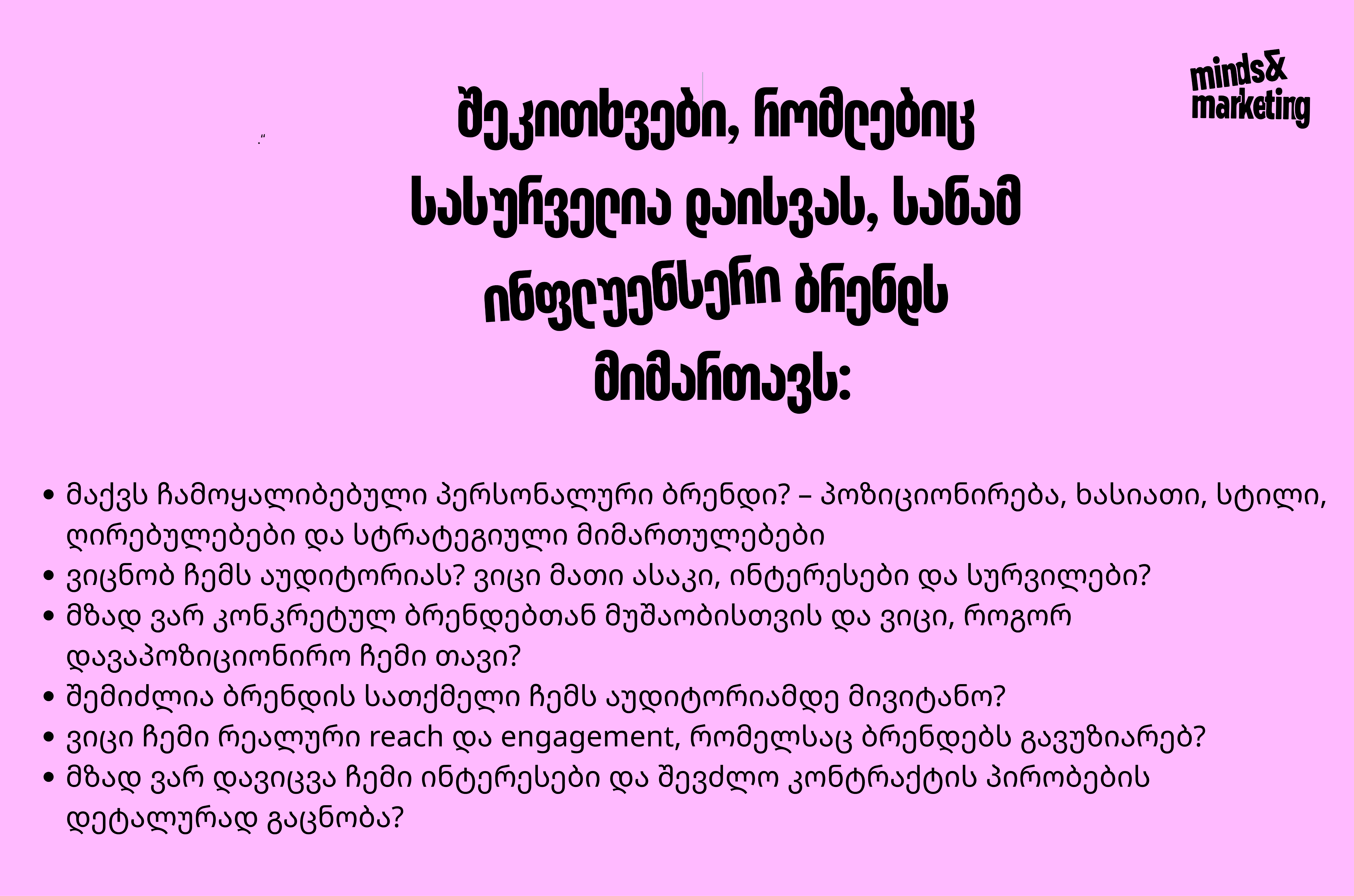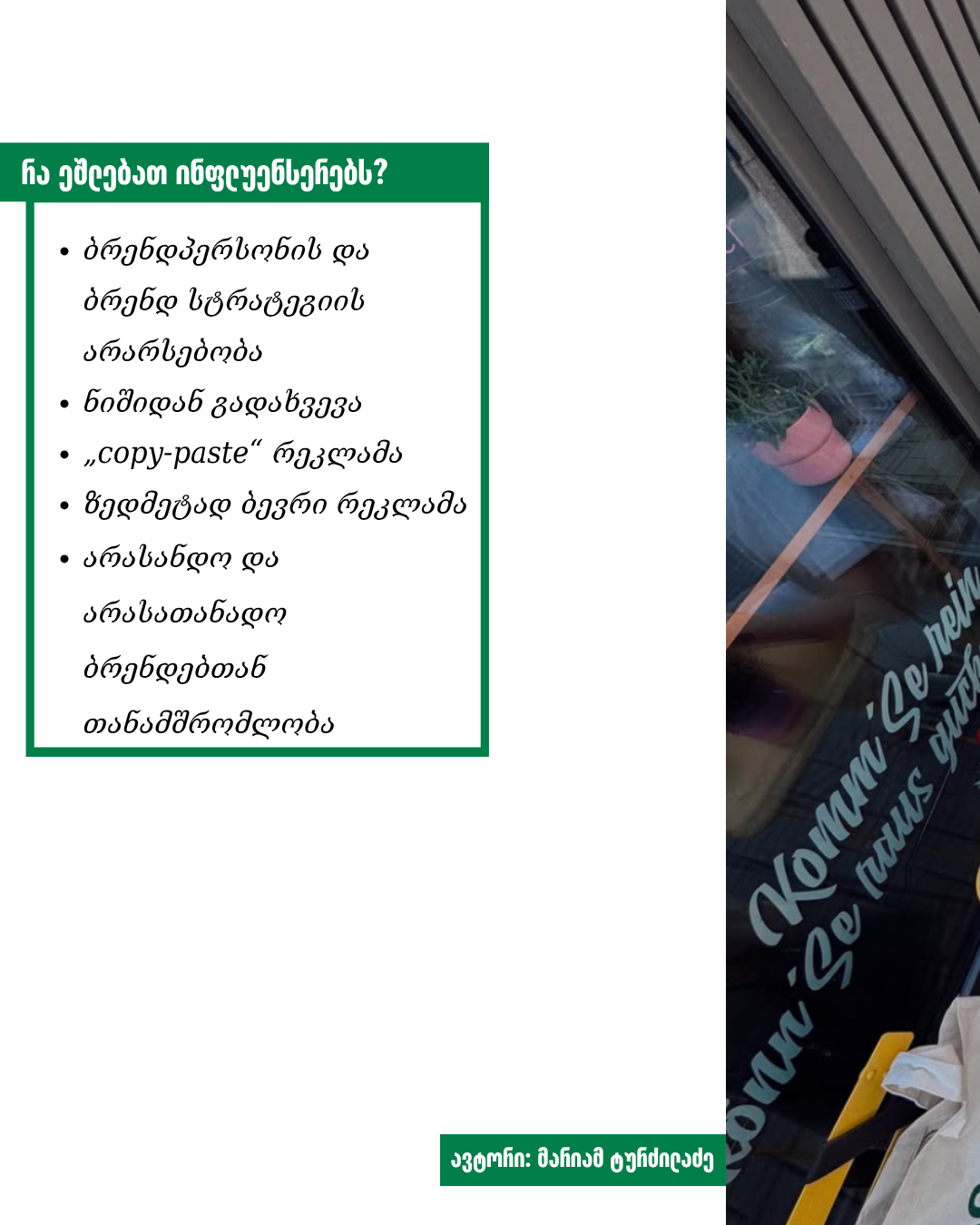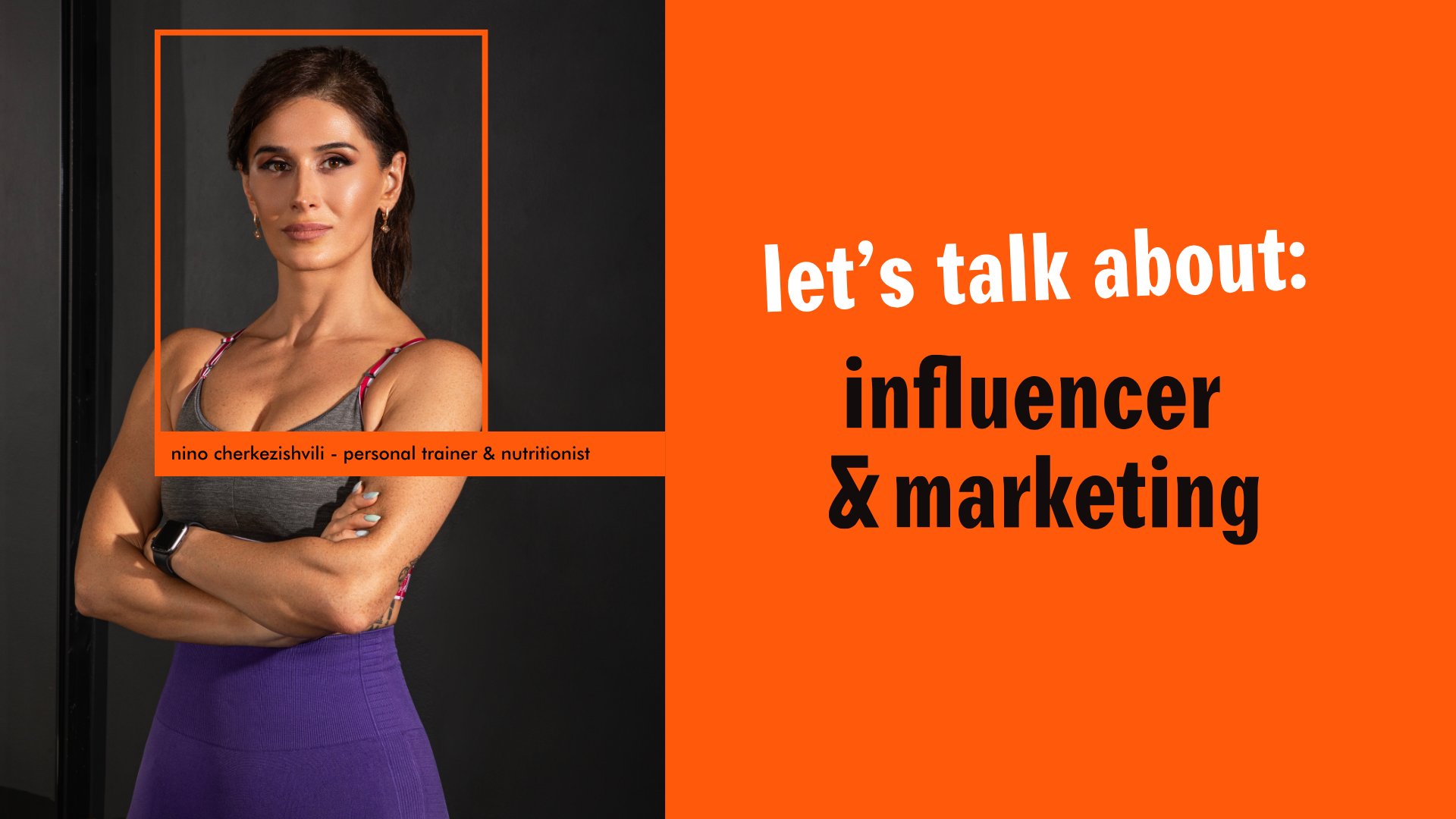where do we stand, what are we doing right or wrong?
influencer marketing in georgia
Successful influencer marketing has long stopped being just about the number of followers. Whether we’re talking about influencers, content creators, or KOLs (Key Opinion Leaders), international brands follow specific criteria when deciding who to partner with for a product launch or campaign—criteria designed to ensure real results.
But what about Georgia? Do influencers here have a well-defined personal brand strategy? How do they work with brands? How do they create content, and how is success measured?
In today’s article, we’ll explore these questions and take a closer look at the current state of the influencer marketing ecosystem in Georgia.
influencer marketing for business
Globally, influencer marketing continues to grow in popularity and demand. Brands are increasing their budgets, establishing long-term partnerships, and seeing high returns on investment. Let’s take a look at some key statistics:
- In 2024, the global influencer marketing market reached $24 billion. By 2025, it's expected to grow to $32.6 billion—a 35%+ increase compared to the previous year.
- 52–75% of global brands and marketing agencies now allocate a separate budget specifically for influencer marketing.
- 26% of brands dedicate more than 40% of their total marketing budget to influencer marketing alone.
- The fashion industry invests the most in influencer marketing, followed by the travel and food sectors.
- In the United States, by 2025, the budget allocated to influencers is projected to surpass the spending on traditional marketing channels.
- For every $1 spent on influencer marketing, businesses earn an average return of $5.80 to $6.50.
- 53% of Gen Z and Millennials say that influencers significantly impact their purchasing decisions.
what’s happening in georgia?
In Georgia, comprehensive marketing research—both quantitative and qualitative—is still limited. However, CommSchool’s 2025 "Georgia Trends Report" provides some useful insights.
According to the report, marketers are now taking collaborations with creators more seriously and viewing them as long-term partnerships.
“Many participants say that smaller influencers with trusted audiences across various platforms often deliver better results. Marketers understand that creators have more credibility with their audiences than brands do. They also notice that forced advertising irritates users, which is why giving creators creative freedom is becoming more common,” the report states.
Even though influencer marketing is growing, some companies still prefer to create content in-house, using creators behind the scenes. Creators without strong personal channels often choose to work with one or several companies directly. In such cases, it’s the content—not the face—that sells the product, and the influencer's personal impact is minimal.
This trend is also noted in the report:
“25% of surveyed companies don’t outsource content creation at all. For 50% of them, 81% to 100% of content is created internally.”
who’s creating content today – and who really has influence?
Both globally and locally, the popularity of influencer marketing and content creation surged during the pandemic. There are even jokes about it now, like: “That’s me – going back to a corporate job because I did not dance during the pandemic.” Funny — and not far from the truth. Even if not everyone started with dance videos, most had to leave their comfort zone before becoming creators, and later, influencers.
We spoke with several influencers, and one thing became clear: even many well-known influencers — the ones we often consider “personal brands” — don’t actually have a defined personal brand strategy. That consistency might stem from strong personal values, taste, or principles. Many of them acted on intuition at first and learned along the way. But today, with growing competition, having a clear niche and strategy is essential for any aspiring influencer.
Nutritionist Ruska Gvamichava (@rgnutritionist) says she didn’t plan her personal brand in the beginning — it just evolved naturally over time:
“My blog is academic, but also friendly — I share personal moments from daily life. It wasn’t a planned tone; I just followed my content. Now, it’s become natural: people associate me with certain products or even words — like coffee or avocado.”
Fitness, workouts, marathons… if these words make you think of Cherry, then Nino Cherkezishvili’s brand strategy worked. Known as Cherry, Nino is both a creator and influencer who quickly built a digital marketing team after launching her blog to ensure every message was answered and her social media brand evolved professionally.
Nino Cherkezishvili (@cherrys_fitness):
“If someone in Georgia thinks of fitness, I want them to think of Cherry. That was my main goal. That’s why my pricing was low from the start — I wanted to reach as many people as possible. One of the key elements of my strategy was to build a strong, loyal community with emotional ties to my brand. That’s why people in my marathon receive daily motivational letters — to keep going.”
Nino says her previous experience helped her define a clear strategy from the beginning:
“I started blogging in 2017, just as I was finishing a personal training academy in the UK, where they teach you to view the profession as a business. I needed a digital space to promote my remote services. My strategy was to share engaging content for free, grow my following, and later introduce paid services. So I began writing informative posts to share basic nutritional knowledge. Soon after, I launched my first free marathon, attracting 250 women. The results were so impressive that, once shared, my follower count skyrocketed.”

when is an influencer ready to collaborate with a brand?
Nowadays, a high follower count no longer plays a decisive role in choosing influencers. In fact, micro-influencers often deliver better results, and brands are beginning to understand that content quality and audience engagement matter most.
Eleniko Rukhadze (@foxy_eleniko):
“When I first started working with brands, companies only cared about numbers. If you didn’t have a 'K' next to your follower count, they wouldn’t even notice you. That was mostly because of Instagram. TikTok made it much easier for micro-influencers to reach large audiences—even starting from zero followers. Brands realized that numbers don’t mean much, and micro-creators often have better engagement. So, if you’re in this field, you need to be ready to collaborate with brands at any time.”
Ruska Gvamichava (@rgnutritionist):
“I had been blogging for over a year before I started working with brands. That’s also when I realized that I should be the one reaching out to them. I remember sending a few proposals for test collaborations—some replied, some didn’t. Now, things have become much simpler. The key is to have a defined niche and stand out in some way. In that case, it doesn’t matter whether you have 15,000 or 5,000 followers.”
based on interviews with influencers and international experience, we can conclude that an influencer is ready to work with brands when:
- They have a clear identity, content direction, and a defined niche (fashion, health, travel, tech, etc.) along with their own tone, style, and vision. Most importantly, they stay consistent and focused on quality.
- They have a stable and engaged audience. Follower count alone isn’t enough—engagement (comments, shares, etc.) is far more important.
- They share common values with the brand and are sure their audiences are not in conflict. For example, a baby food brand won’t collaborate with someone who frequently posts about alcohol or controversial content.
questions influencers should ask before approaching a brand:
- Do I have a defined personal brand? (Positioning, personality, style, values, strategic direction)
- Do I know my audience—age, interests, and desires?
- Am I ready to work with specific brands, and do I know how to position myself?
- Can I convey the brand’s message to my audience?
- Do I know my actual reach and engagement metrics that I can share with the brand?
- Am I prepared to protect my interests and review contract terms thoroughly?
influencers' red flags when collaborating with brands
A well-established personal brand and audience trust place a big responsibility on influencers. There are many local and international cases where influencers lost a large portion of their followers due to collaborations with the wrong brands. Rebuilding a reputation and regaining trust is extremely difficult. If “slimming tea” or “financial pyramids” came to mind, so did the influencers associated with them. Are you still following those people?
We asked influencers what red lines they would never cross.
Eleniko Rukhadze (@foxy_eleniko):
“A brand I collaborate with must align with my interests and stay within my niche. It must not be Russian! It must provide the same quality of service to others as it does to me. I always refuse products that can harm someone's mental or physical health—slimming teas, nicotine, vapes, alcohol, gambling. Communication also matters a lot—if a brand doesn’t know me as a creator, doesn’t understand my audience, or is only focused on selling a product without a clear goal—I'm no longer interested.”
Ruska Gvamichava (@rgnutritionist):
“My niche is directly connected to health, so I choose partners very carefully. The responsibility is huge. First of all, our values must align. I’ve received offers for slimming pills and teas—that’s a clear sign the brand hasn’t done their homework on my blog. Some brands also try to overly control the content, sending ready-made scripts they expect to be followed word-for-word. In such cases, I explain that I know my audience best and must deliver the message in my own style.”
Nino Cherkezishvili (@cherrys_fitness):
“I’m very careful about which brands I work with. I prefer long-term collaborations and don’t accept one-off deals. I also sell my own services, and I don’t like seeing too much advertising on other influencers’ profiles either. That’s why my strategy is to do a few long-term collaborations with brands that align with my values and niche. This is one reason why my blog maintains high trust with both followers and brands.”
common mistakes influencers make
Many influencers still don’t realize that they are already a brand—and every post is both commercial communication and personal content. Mistakes—even by big influencers—not only damage their image short-term but affect long-term trust. Common mistakes include:

- Lack of brand persona and strategy – Many influencers still haven’t defined themselves as a brand. They lack a niche, core values, tone, or content direction. Operating without strategy often means the brand or audience will assign them an identity by default, which takes control away from the influencer and can lead to lost followers or poor-fit collaborations.
- Drifting away from the niche – Interviewees often mentioned this: you must protect your niche. If someone’s content is about books and suddenly they advertise makeup, followers who joined for the book content may lose interest.
- Copy-paste advertising – Sure, sometimes brands request this, but is it worth it? If it’s part of a viral campaign, maybe. But when dozens of influencers post the same script at once, the ad feels fake and reduces audience trust.
- Too much advertising – Everyone starts with content, but as offers increase, so does temptation. It’s crucial to pace promotions and ensure the feed doesn’t turn into a stream of ads. Audiences react negatively to excessive ads, and the most important thing—trust—is put at risk.
- Collaborating with unreliable or inappropriate brands – A short-term paycheck isn’t worth partnering with brands whose credibility is questionable. At a minimum, influencers must research the brand and its products before advertising. This shows respect for both the audience and oneself. And yes, we're thinking of slimming teas and financial pyramids again.
conclusion:
Influencer marketing in Georgia is steadily entering a phase of maturity and being taken seriously. The number of followers, once a top metric, now only partially reflects real influence.
Trust, consistency, value alignment, content quality, and audience loyalty—these are the true measures of success.
Our research and interviews show that professional growth in this field starts with the right questions, not just with allocated budgets.
When choosing an influencer, a brand must understand what it needs...
References:
For further investigation:
• How brands collaborate with influencers – interviews with representatives from marketing departments of various companies
• How influencers build businesses – Georgian case studies
• Kids & Family influencers – children, parents, and moral boundaries



